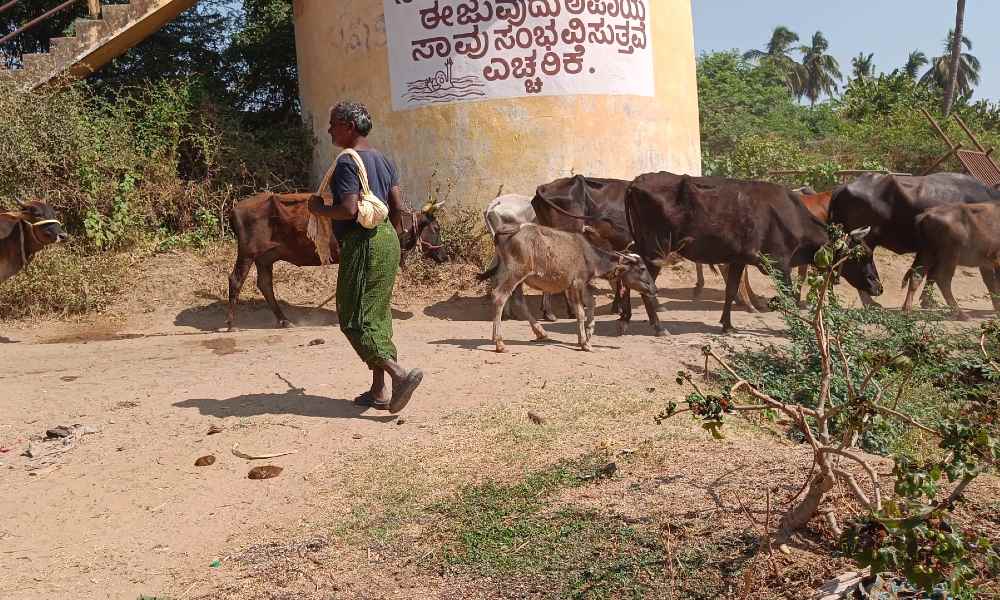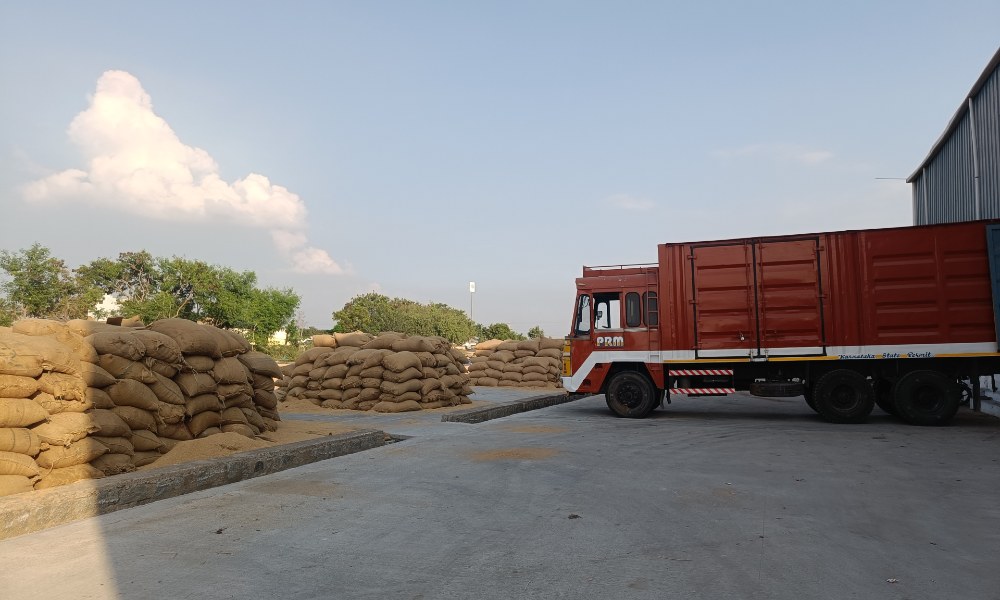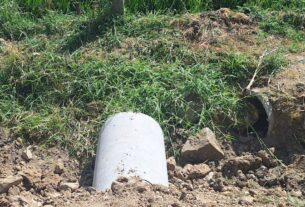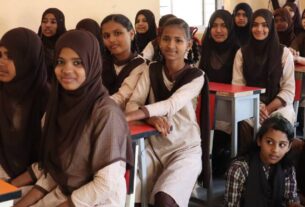“We are farmers, we are not beggars,” say farmers in Gangavathi, frustrated by the disregard for farmers’ issues and unfulfilled drought relief promises.
The haystack turned golden red, reflecting the light of the setting sun. Srinivas took a handful of hay near the barren paddy field and fed the buffalos. Those buffaloes are currently the only source of income for his family which has been dependent on paddy farming for years.
Srinivas continued the farming legacy of his family which began when his grandfather migrated to Gangavathi from Andhra Pradesh. Gangavathi is now known as the “Rice bowl of Karnataka.” Just like Srinivas, the livelihood of a lot of people in Gangavathi revolves around paddy farming. The fate of the farmers in Gangavathi took an unexpected turn last year, as the taluk didn’t receive enough rainfall.
Last year, as every year, the farmers were prepared to sow and harvest paddy. The water for irrigation is usually filled in the canals from the Tungabhadra reservoir. The farmers got enough water for the first crop from the canal. However, this year, there was no water for the second crop, forcing farmers to skip the second crop.
Gangavathi is a taluk in the Koppal district of North Karnataka. The average annual rainfall in Gangavathi is 365mm. According to the data provided by the Krishi Vigyan Kendra, last year the taluk received 332 mm of rainfall. The water from Tungabhadra is used for drinking and irrigation purposes.
Dr. A.V Karegowda, a scientist from the Indian Council of Agricultural Research (ICAR) said that, while Gangavathi is called the “Rice bowl of Karnataka,” in reality, the land in Gangavathi is not suitable for paddy cultivation. The soil in Gangavathi is black cotton soil which is not meant for irrigation. Because of the lateral movement of water in the soil, the bore wells won’t get recharged there. “In 1953, when the Dam was constructed, the area wasn’t meant for paddy cultivation,” he said that when the dam was constructed, the government suggested cultivating paddy wherever there was excess water. Karegowda added that violation of cropping pattern, salinity, and water logging are the main issues in Gangavathi.
Dr. J. Viswanath, Dean, ICAR, said that people shifted to paddy cultivation after 1980 when people from Andhra Pradesh migrated to Gangavathi. Paddy is a type of crop that requires complete flooding for irrigation. So, it needs a lot of water. When the Tungabhadra reservoir was built some guidelines were put forth for crops and irrigation in the command area. Unscientific irrigation practices are one of the reasons for water deficiency.
Farmers said that they haven’t received any support or relief from the government side. However, the irrigation department thinks that farmers are partly responsible for the current issue. Viswanath H, Technical Assistant, Irrigation Department said that the farmers are violating the crop pattern and growing paddy everywhere. “Water management is a tough job,” he said. Viswanath said that the irrigation department is planning to adopt a rotation system. “When we release water into the canal, it’s not distributed simultaneously to all the farmers,” he said. Right now, the farmers near the Tungabhadra reservoir have an upper hand over the mid-end and tail-end farmers.
A case study conducted by the Department of Agricultural Economics, University of Agricultural Sciences, GKVK, Bengaluru, Karnataka, India, “Vulnerability to Food and Nutritional Insecurity in Different Reaches of Tungabhadra Command Area of Karnataka: A Case Study,” mentions the importance of irrigation in improving food security. The study conducted around the Tungabhadra command area linked the shortage of irrigation water to nutritional security across the command area. They found that the people in the tail-end and middle-end are highly vulnerable to food insecurity. Also, they found a relation between the monthly income and proximity to the Tungabhadra reservoir.
Dr. Mahantashivayogayya, ICAR scientist, said that even though the farmers with bore wells tried other paddy varieties, they had to face seedling death. He is currently investigating to find reasons for seedling death. Mahantashivayogayya believes that it is due to the high climate change and high salinity in bore well water. “It’s very tough for the farmers now,” he sighed, “this summer, our farmers are free.”
The scientists at ICAR said that the farmers in Gangavathi have been cultivating paddy for years. “Paddy is the main product here. Rice is exported from here to all parts of India,” said Dr. Mahantashivayogayya.
Most farmers are stuck to monocropping patterns. Dr. Pooja, author of the study “Vulnerability to Food and Nutritional Insecurity in Different Reaches of Tungabhadra Command Area of Karnataka,” said that most farmers don’t know how to cultivate other crops nowadays. “They (farmers) see more value in paddy and think that they are accustomed to growing paddy. That’s a problem,” she said.
Maulo Sab, like Srinivas, is concerned about the lack of rainfall. He doesn’t know how to provide for his two children who are going to school. “I’ve been farming my whole life. I don’t know anything else. I don’t have any job to do,” he said. Sorrow and concern about the future reflected in his eyes as they teared up. Farmers like Maulo Sab battle every day to move forward in life. No one is willing to give loans to the farmers as they know that the farmers can’t repay.
Srinivas is barely able to make ends meet. His wife met with an accident last year and broke her hand. She went through an operation and is recovering. They could barely afford the money. He took a loan, keeping his buffaloes as collateral. Srinivas has no idea how to repay the loan.
Veereshappa, a paddy land owner said that farmers should get seeds, water, fertilizers, and pesticides for free. “If they didn’t get any one of that, it would affect the farmers. They didn’t get Bara Parihara (drought relief) yet,” he said.
Viswanath said that the irrigation department is charging the farmers Rs.12 for 1000 cubic meters of water. Pooja observed that charging money for irrigation water gives the farmers a sense of responsibility to not overuse water.

Ramakrishna, a farmer said that the farmers deserve to get more support from the government than the Rs.2000 relief. “We are farmers, we are not beggars,” he was frustrated by the thought of reducing farmers’ issues to “a mere amount” that they haven’t even received yet.
The state government declared 195 taluks as drought-affected, including Gangavathi. The government announced the release of Rs105 crore from the State Disaster Relief Fund (SDRF) to compensate drought-hit farmers on January 05, 2024. That is, to provide a minimum of Rs. 2000 per farmer. But, none of the farmers in Gangavathi received the relief.
Channa Baswa, agriculture officer at Gangavathi said that the farmers had to cancel one crop this year due to the availability of water because of the lack of rainwater. He said that the paddy farmers won’t get the relief fund. “Drought relief will only be given to the crops in which water is very necessary. Paddy needs a lot of water. Other farmers, apart from the paddy farmers will get relief,” he said.
India is the largest rice-producing country after China. The data from Statista reveals that Karnataka contributed to over four million metric tons of rice production in India, in FY 2021. According to the State-wise rice productivity analysis, Koppal is the top district in Karnataka which contributes to rice production. Studies suggest that Gangavathi is one of the major paddy arrival markets in Karnataka.
The quandaries of farmers are reflected in other sectors in Gangavathi as well. Lokesh runs a tea shop near the paddy field near Gangavathi railway station. Farmers and laborers usually come to his shop to have tea, his famous idli, and Chilly bhaji. “Farmers come to our shop to eat, after working in the field. If the farmers don’t have money, even we don’t get business,” Lokesh said that everyone in the village is affected by the crop loss, one way or another.
Muhammed Naheem, owner of Veerabhadreshwara Rice Mill said that the rice mill business is gravely affected by the lesser arrival of rice. “It’s tough to run the mill right now. We are not able to give salaries to the employees. The mill requires Rs. 7 lakh to Rs. 8 lakh electricity bill monthly,” he said.
According to the data from Krishi Marata Vahini, paddy arrivals to the Agricultural Produce Market Committee (APMC) at Gangavathi are almost 17 lakh quintals from April 2023 till now. From 2022 April to March 2023, the paddy arrivals were more than 25 lakh quintals.
However, Harish Pattara, Assistant Secretary at APMC Gangavathi said that after 2020, the farmers don’t need to compulsorily sell the paddy at APMC. “We could regulate the farmers directly before. But now, they sell their products outside the mandi. So, we don’t have the exact numbers,” he said.
The New Farm Acts of 2020 allowed farmers to sell their produce directly to consumers. The APMC regulations helped the farmers from exploitation and helped remove malpractices from markets. It created orderly and transparent marketing conditions.
Dr. Viswanath said that scientists and breeders are working on resolving the issue. “Repairing is done on one side. On the other side, the farmers need to be educated to reduce groundwater and soil exploitation,” he said. However, Dr. Jyothi, a scientist at ICAR said that rainfall is the only permanent solution to the current issues.
The weight of these concerns lingered in the mind of Srinivas, a strong reminder of the dependence of farmers like him on the whims of nature.
Srinivas fed the buffaloes. He took a steel container and rode away on his old scooter. He had to sell a mere two to three liters of milk to keep the house running. Several thoughts shadowed in him. The scorching sun was about to resign for the day. Every day, the sun sets in Gangavati with the prayers and hopes of the farmers to receive good rainfall next year.




